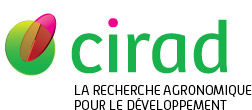Dakouo Dona.
2001. La cécidomyie du sorgho : bioécologie et pertes.
In : Les insectes ravageurs du sorgho en Afrique de l'Ouest et du Centre : actes = Insects pests of sorghum in West and Central Africa : proceedings. Ratnadass Alain (ed.), Ajayi Olupomi (ed.), Marley Paul S. (ed.), Akintayo Inussa (ed.). CIRAD, ROCARS, ICRISAT
|
Version publiée
- Français
Accès réservé aux personnels Cirad Utilisation soumise à autorisation de l'auteur ou du Cirad. ID478734.pdf Télécharger (45kB) |
Titre anglais : Bioecology of sorghum midge and crop losses
Résumé : Stenodiplosis sorghicola is the most widespread sorghum insect pest worldwide. The adult midge resembles a mosquito. Females are longer-lived than males, namely ca. 24 h vs. a few hours. They lay individually an average of 25 eggs inside sorghum spikelets at the time of anthesis. After hatching, maggots feed on the developing seed, preventing normal grain development, which results in abortion, and partial or total destruction of the grains. Total life cycle is about 2-3 weeks, and there are several generations per year. As rains become scarcer at the end of the rainy season, which translates into lower relative humidity, more and more larvae weave cocoons and enter into diapause. In West Africa, timing and importance of pest outbreaks vary according to the countries. Stenodiplosis sorghicola is endemic to all areas where cultivated and wild species of the genus Sorghum are to be found. Natural parasitism is low and takes place late in the season. The main genera of parasitic microwasps are Tetrastichus, Eupelmus and Aprostecetus. Damage caused to crops by the pest vary depending on agroclimatic conditions in each zone. Pest outbreaks are favored by late or staggered sowings, which result in an extension of the flowering period. Under such conditions, yield losses are reported to be high, although variable, namely ranging from 50 to 100% in Nigeria, Senegal and Burkina Faso. In Mali and Kenya, losses are reportedly lower (20-30%). The pest is also considered to be of economic importance in Chad, Niger, Benin, Togo and Cameroon.
Mots-clés Agrovoc : Sorghum, insecte nuisible, Contarinia sorghicola, cycle de développement, dégât, perte
Mots-clés complémentaires : Stenodiplosis sorghicola
Classification Agris : H10 - Ravageurs des plantes
Auteurs et affiliations
- Dakouo Dona, INERA (BFA)
Autres liens de la publication
Source : Cirad - Agritrop (https://agritrop.cirad.fr/478734/)
[ Page générée et mise en cache le 2024-01-28 ]




